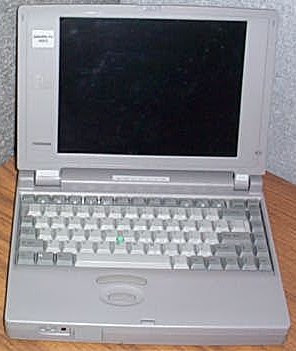 My Toshiba Satellite Pro 400CS went toes up in 2006 after many years of service. It died with a horrible grinding sound from the hard disc. I tried to bring it back to life, and bought a replacement HD, but I never could get it going and the project got sidetracked... until an e-mail from Kevin, ZL3KE, (see below) got me back in the old computer repair business.
My Toshiba Satellite Pro 400CS went toes up in 2006 after many years of service. It died with a horrible grinding sound from the hard disc. I tried to bring it back to life, and bought a replacement HD, but I never could get it going and the project got sidetracked... until an e-mail from Kevin, ZL3KE, (see below) got me back in the old computer repair business.With long-distance help from Kevin I
1) Got a boot-able DOS disc, which got me to an A:
2) Partitioned and formatted my HD which got me a C:
3) Loaded DOS drivers for my CD ROM drive which got me a D:
4) Used the CD-ROM drive to load Windows 3.1 which really brought this thing back to life.
I usually dislike working on computers, but with Kevin's help and encouragement, this project was fun. And I can now use some old programs that I haven't been able to use since the advent of Windows 95, like my favorite astronomy program "Distant Suns." I'm also running ON7YD's excellent QRSS transmit program.
I always liked the audio features of this computer. With a bit of driver downloading, I now have sound. There are some nice audio clip files in this (birds chirping, machine guns, another gong!)
that may find their way into the podcast.
Any thoughts on what else I can do with this machine? Any other Windows 3.1 applications?
Here's the message from Kevin that re-started all this:
Minimalist/QRP computing
I was amused to hear your comments about QRSS and the ever-so-slight
discrepancy between the number of transistors needed for Rx and Tx...
Maybe it's time to introduce the concept of the "QRP Computer" - using
older/slower hardware generally regarded as obsolete, but otherwise
perfectly serviceable and having a much smaller carbon footprint than the
latest 2.5GHz+ machines! This is something which I've been working towards
for some time.
I'm typing this on an old 233MHz Pentium laptop (Toshiba Satellite Pro
480CDT), with 64MB of RAM, a 3.8GB hard disk and an 800x600 screen,
running a cut-down version of Win98SE with all web integration (IE etc.)
stripped out. This will happily run pretty much all the radio software I
need without complaint (such as MMTTY for RTTY, MMSSTV for SSTV, Digipan
for PSK31, Argo, Spectran, IZ8BLY Hellschreiber, WSJT v4, etc).
Just about the only thing lacking is WSPR, which I would very much like to
run but I think it probably needs more resources than this machine has
(Joe Taylor, are you listening? ;-).
The rationale was/is to find the simplest, smallest, most bloat-free
programs to accomplish what is needed (minimalist computing, in other
words) - and it must all be freeware or similar - bells & whistles are
frowned upon, and definitely no commercial stuff allowed! I wouldn't say
I'm 100% there yet, but the journey so far has been interesting and
rewarding.
Although this was originally intended to be a dedicated machine for radio,
I now find myself increasingly using it for things like web-browsing and
email as I find the whole "no bells & whistles" experience quite
refreshing (I use Popcorn email and a minimalist, no-javascript browser
called "OffByOne" - my browsing needs tend to be fairly basic and I tend
to regard any website which uses Java/Flash etc. as not worth the effort).
I think Mike AA1TJ's quote on his "Reggie" page is quite apt here: "In
anything at all, perfection is finally attained not when there is no
longer anything to add, but when there is no longer anything to take
away...."
72/3, Kevin
ZL3KE


























